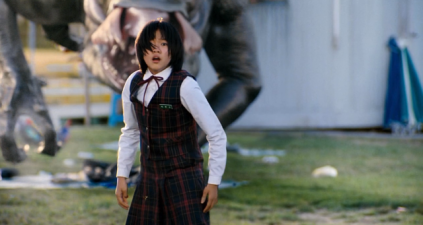
Korean film: The Host
Just in time for Halloween, EAS at OSUL would like to introduce our Korean Horror Film Collection!
한 (Han) in Korean Horror films
Modern Korean horror films are unique because they serve as contemporary reflections of the Korean concept of 한 (Han). 한 (Han) is roughly translated as hatred or resentment, but extends much further– it refers to the unresolved, lingering collective pain that resides in the Korean psyche, born from the nation’s often traumatic history. Theologian Su Nam-dong described 한 (Han) as the “feeling of unresolved resentment against injustices suffered, a sense of helplessness because of the overwhelming odds against one, a feeling of acute pain in one’s guts and bowels, making the whole body writhe and squirm, and an obstinate urge to take revenge and to right the wrong—all these combined.” (Yoo, 1988) The concept of 한 (Han), with its connotations of revenge and suppressed rage, permeate Korean horror films, most obviously through ghostly manifestations of revenge, but also through common themes, motivations, and motifs.
Korean films are a part of 한류 (Hallyu)
Modern Korean horror films are also important as they are a component of 한류 (Hallyu), or the Korean Wave. 한류 (Hallyu) is the global spread and increased popularity of Korean popular culture, including K-pop (Korean pop music), K-dramas (Korean soap operas), and Korean films. Many of the most popular and well-known Korean films abroad have been horror films, including the recent Train to Busan (Original title: 부산행 / Busanhaeng) and monster movie The Host (Original title: 괴물 / Gwoemul).
Influential Korean Horror Films
Below are some of the most influential Korean horror films that can be found EAS at OSUL’s collection. Please note that users must have OSU credentials to access movies through Kanopy.

Whispering Corridors (1998)– This classic Korean horror film can be seen as sparking the Korean horror film resurgence in the 1990s, and it helped define the genre, starting the trend of using female ghosts, high school settings, and repressed, unending 한 (Han) as major themes. It was the first in a series of popular Korean horror films, including Memento Mori (1999), Wishing Stairs (2003), Voice (2005), and A Blood Pledge (2009). Although each entry into the series share a high school setting, the plots, characters, and locations unrelated. The original film deals with a teacher who returns to her former high school as mysterious murders begin to occur.
 A Tale of Two Sisters (2003) – Another influential Korean horror film, A Tale of Two Sisters is based on the folk tale, Janghwa Hongreyon-jon. The story centers around two young girls returning home from a mental institution to their father and evil stepmother, and the supernatural events that begin upon their arrival. It won many awards both domestic and abroad, and spawned a Hollywood remake: The Uninvited.
A Tale of Two Sisters (2003) – Another influential Korean horror film, A Tale of Two Sisters is based on the folk tale, Janghwa Hongreyon-jon. The story centers around two young girls returning home from a mental institution to their father and evil stepmother, and the supernatural events that begin upon their arrival. It won many awards both domestic and abroad, and spawned a Hollywood remake: The Uninvited.
 The Host (2007) – Korea’s take on the monster genre, The Host was the top grossing South Korean movie of all time when it was released, and features a cast and crew which would later go on to become international stars, including director Bong Joon-ho (Snowpiercer, Okja), actress Bae Doo-na (Cloud Atlas, Sense8), and actor Song Kang-Ho (Joint Security Area, Sympathy for Mr. Vengence). The story revolves around a giant, hideous creature that emerges from the Han river and kidnaps a man’s daughter. The man and his family then set out on a rescue mission to save the little girl.
The Host (2007) – Korea’s take on the monster genre, The Host was the top grossing South Korean movie of all time when it was released, and features a cast and crew which would later go on to become international stars, including director Bong Joon-ho (Snowpiercer, Okja), actress Bae Doo-na (Cloud Atlas, Sense8), and actor Song Kang-Ho (Joint Security Area, Sympathy for Mr. Vengence). The story revolves around a giant, hideous creature that emerges from the Han river and kidnaps a man’s daughter. The man and his family then set out on a rescue mission to save the little girl.
Other Korean Horror movies available at OSUL:
Phone. Directed by Ahn Byeong-ki. Starring Ha Ji-won and Kim Yoo-mi
Sorum. Directed by Yoon Jong-chan. Starring Kim Myung-min and Jang Jin-young
Root of Evil (Acacia) . Directed by Park Ki-hyeong. Starring Shim Hye-jin.
For information about the Korean Horror genre, please check out some of EAS’s resources (links below):, Starring The Red Shoes. Directed by , Starring
Peirse, A., & Martin, D. (2013). Korean horror cinema. Edinburgh: Edinburgh University Press.
References

